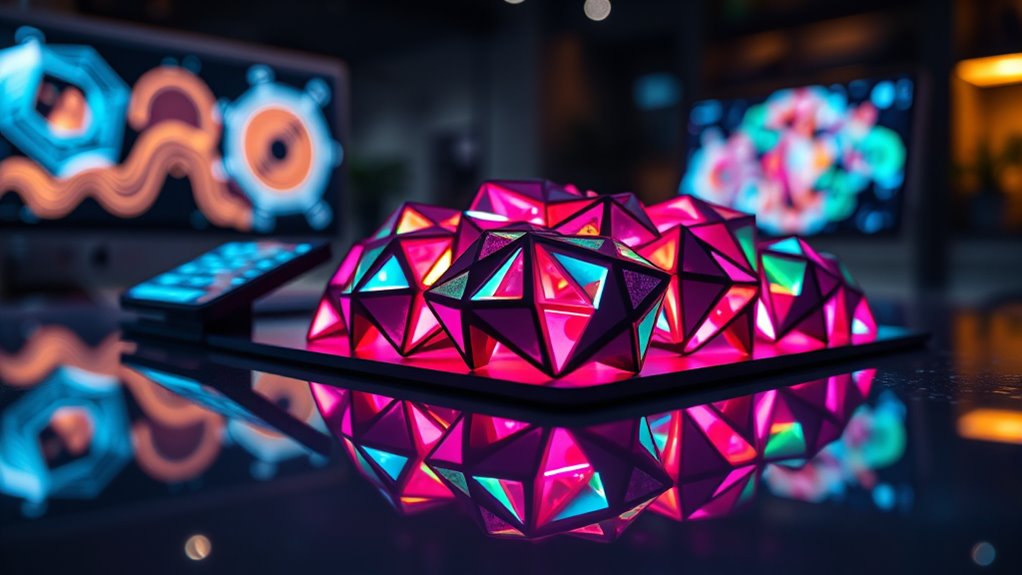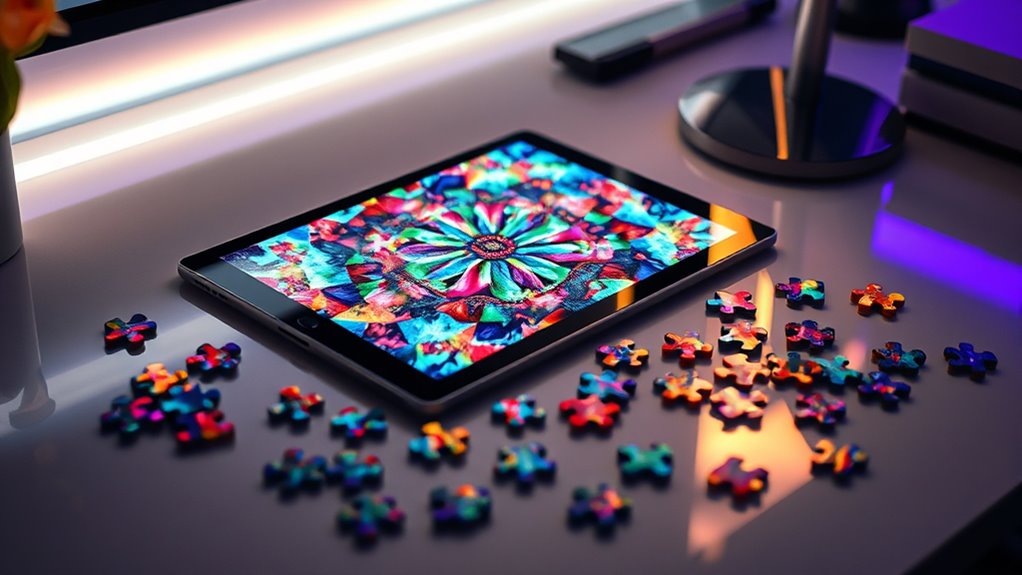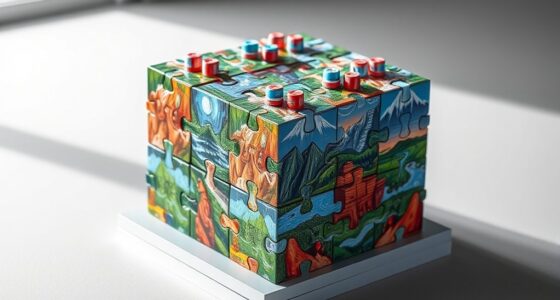AI-generated puzzles are challenges created by algorithms that analyze vast data to craft unique, dynamic, and personalized problems. They often adapt in real-time, adjusting difficulty based on your skill level and providing endless variety. These puzzles explore new formats and themes, pushing traditional boundaries. To play, you follow intuitive interfaces that guide your progress. Continue exploring how this innovative technology can transform your puzzle experience and keep you engaged with fresh challenges.
Key Takeaways
- AI-generated puzzles are created using algorithms that analyze data to produce engaging and unpredictable problem-solving challenges.
- These puzzles are designed to be both challenging and solvable, often adapting in real-time to player skill levels.
- They explore innovative formats, combining creativity, pattern recognition, and genre blending beyond traditional puzzle design.
- To play, users typically interact through intuitive interfaces that guide solving and adjust difficulty dynamically.
- Playing AI-generated puzzles offers a personalized experience that fosters discovery, continuous challenge, and cognitive engagement.

Have you ever wondered how artificial intelligence is transforming the world of puzzles? AI-generated puzzles are a fascinating example of how technology pushes the boundaries of traditional gameplay, offering fresh challenges and innovative designs. At their core, these puzzles are crafted by algorithms that analyze vast amounts of data to produce engaging, often unpredictable, problem-solving experiences. But understanding how AI creates these puzzles involves delving into concepts like algorithm complexity and creativity in design.
Algorithm complexity plays a vital role in generating puzzles that are both challenging and solvable. Sophisticated algorithms process millions of possible configurations, adjusting difficulty levels dynamically based on user interaction or predefined parameters. This complexity guarantees that each puzzle is unique, avoiding the repetitive patterns sometimes seen in manually created puzzles. As a player, you might notice that AI-generated puzzles can adapt in real-time, increasing or decreasing difficulty to match your skill level, making the experience more personalized and engaging. This adaptiveness is made possible by complex algorithms that evaluate numerous variables simultaneously, ensuring the puzzles remain stimulating without becoming frustrating.
AI algorithms ensure unique, adaptable puzzles that challenge and engage players in real-time.
When it comes to creativity in design, AI pushes the boundaries of what’s possible in puzzle creation. Traditional puzzles often rely on human intuition and artistic vision, but AI introduces a new level of innovation by combining vast data analysis with pattern recognition. It can generate entirely novel puzzle types or blend elements from different genres to produce something unexpected yet logical. This opens up endless possibilities for puzzle design, from intricate logic puzzles to visually stunning spatial challenges. As a player, you could find yourself solving puzzles that feel fresh and original, because AI can experiment with formats and themes that humans might never consider. This symbiosis of machine intelligence and creative freedom leads to puzzles that are not only fun to solve but also push the limits of what you thought was possible in puzzle design.
Playing AI-generated puzzles is straightforward, yet engaging. These puzzles often come with intuitive interfaces that guide you through the solving process, allowing you to focus on the challenge rather than the mechanics. As you work through them, you may notice how the puzzles seem to anticipate your moves or adjust difficulty, keeping you in a constant state of discovery. Because AI can generate a virtually endless variety of puzzles, you’ll never run out of new challenges to tackle, making your puzzle-solving journey both exciting and continuously evolving. In essence, AI-generated puzzles combine the power of complex algorithms with innovative design, providing a fresh, personalized, and endlessly intriguing experience for puzzle enthusiasts like you.
Furthermore, these puzzles exemplify the intricate workings of the human mind and artificial intelligence, demonstrating how dreams and creative processes can inspire innovative problem-solving methods.
Frequently Asked Questions
Can Ai-Generated Puzzles Improve My Cognitive Skills?
Yes, AI-generated puzzles can improve your cognitive skills by engaging your brain in challenging ways. They often use neural networks to customize difficulty levels, providing ideal mental stimulation. As you solve these puzzles, you enhance problem-solving, memory, and critical thinking skills. Regularly playing them offers cognitive enhancement, keeping your mind sharp and agile. Plus, the adaptive nature of AI ensures you stay motivated and engaged throughout your mental workout.
Are AI Puzzles Suitable for All Age Groups?
AI puzzles are like a welcoming garden where everyone can find age-appropriate challenges that spark their curiosity. They’re truly fun for kids and adaptable for adults, making them suitable for all age groups. Whether you’re seeking simple puzzles or more complex ones, AI-generated options tailor the experience just for you. So, you can enjoy the mental stimulation and entertainment, no matter your age, with puzzles designed to keep everyone engaged.
How Do AI Puzzles Differ From Traditional Puzzles?
AI puzzles differ from traditional puzzles by using complex algorithms that generate unique challenges at various difficulty levels. You’ll notice that AI puzzles adapt to your skill, offering tailored complexity, whereas traditional puzzles are static. This dynamic approach keeps you engaged and pushes your problem-solving skills further. The algorithm complexity guarantees each AI puzzle feels fresh, making it suitable for both beginners and experts seeking a new challenge.
Can I Create Personalized Puzzles With AI?
Yes, you can create personalized puzzles with AI by customizing options like themes, images, and difficulty levels. You get to control the puzzle complexity, making it easier or more challenging based on your preferences. Simply choose your customization options, upload your images or select styles, and let the AI generate a unique puzzle tailored to your interests. It’s a fun way to craft puzzles that truly reflect what you enjoy.
Are Ai-Generated Puzzles Available for Mobile Devices?
Yes, AI-generated puzzles are available for mobile devices, making AI puzzle customization easily accessible. You can find apps that let you create, solve, and personalize puzzles right on your smartphone or tablet. This enhances mobile puzzle accessibility, so you can enjoy tailored challenges anytime. Explore various AI puzzle apps to experience the fun of customized puzzles on the go, all designed for your convenience and entertainment.
Conclusion
As you plunge into AI-generated puzzles, you realize they’re more than just games—they’re gateways to the unknown. Each one challenges your mind, revealing hidden layers and secret patterns that keep you hooked. But what mysteries await as you solve more? The deeper you go, the more you’ll wonder: are these puzzles just the beginning of a new frontier, or is there something even more extraordinary just beyond your reach? The adventure has only just begun.









